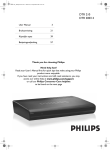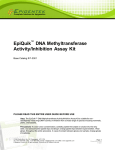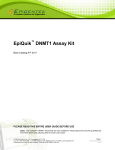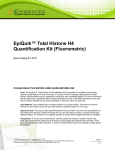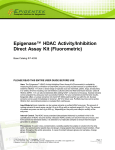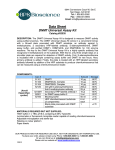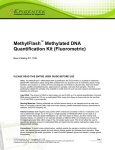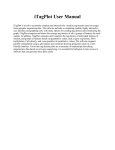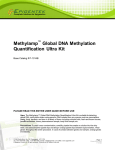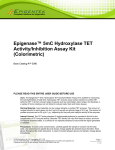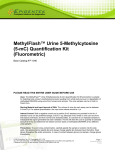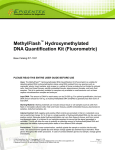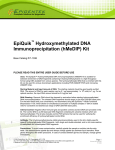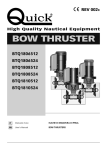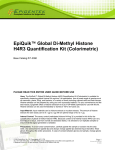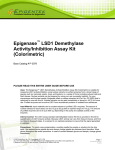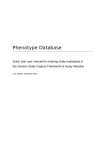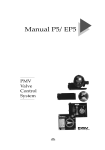Download Epigenase™ 5-mC Hydroxylase TET Activity/Inhibition
Transcript
EPIGENTEK Complete Solutions for Epigenetics EpiQuik™ DNMT Activity/Inhibition Assay Ultra Kit (Fluorometric) Base Catalog # P-3010 PLEASE READ THIS ENTIRE USER GUIDE BEFORE USE Uses: The EpiQuik™ DNMT Activity/Inhibition Assay Ultra Kit (Fluorometric) is suitable for measuring total DNMT activity or inhibition using nuclear extracts or purified enzymes from a broad range of species such as mammalians, plants, fungi, bacteria, and viruses in a variety of forms including, but not limited to, cultured cells and fresh and frozen tissues. Nuclear extracts can be prepared by using your own successful method. For your convenience and the best results, Epigentek also offers a nuclear extraction kit (Cat. No. OP-0002) optimized for use with this kit. Nuclear extracts can be used immediately or stored at –80°C for future use. Purified enzymes can be active DNMTs from recombinant proteins or isolated from cell/tissues. Input Material: Input materials can be nuclear extracts or purified DNMT enzymes. The amount of nuclear extracts for each assay can be between 0.2 µg to 10 µg with an optimal range of 5 µg to 10 µg. The amount of purified enzymes can be 0.2 ng to 100 ng, depending on the purity and catalytic activity of the enzymes. Internal Control: A positive enzyme control is provided in this kit. Because DNMT activity can vary from tissue to tissue, and from normal and diseased states, it is advised to run replicate samples to ensure that the signal generated is validated. Precautions: To avoid cross-contamination, carefully pipette the sample or solution into the strip wells. Use aerosol-barrier pipette tips and always change pipette tips between liquid transfers. Wear gloves throughout the entire procedure. In case of contact between gloves and sample, change gloves immediately. 110 Bi County Blvd. Ste. 122, Farmingdale, NY 11735 Tel: 1-877-374-4368 ■ Fax: 1-718-484-3956 ■ E-mail: [email protected] ■ Web: www.epigentek.com © Epigentek Group Inc. All rights reserved. Products are for research use only. Page 1 Printed 2014-09-22 P-3010 EPIGENTEK Complete Solutions for Epigenetics KIT CONTENTS Component 48 Assays Cat. #P-3010-48 96 Assays Cat. #P-3010-96 Storage Upon Receipt MK1 (10X Wash Buffer) 14 ml 28 ml 4°C MK2 (DNMT Assay Buffer) 4 ml 8 ml RT MK3 (Adomet, 50X)* 60 µl 120 µl –20°C MK4 (DNMT Enzyme Control, 50 µg/ml)* 6 µl 12 µl –20°C MK5 (Capture Antibody, 1000 µg/ml*) 5 µl 10 µl 4°C MK6 (Detection Antibody, 400 µg/ml)* 6 µl 12 µl –20°C MK7 (Enhancer Solution)* 6 µl 12 µl –20°C MK8 (Fluoro Developer)* 6 µl 12 µl –20°C MK9 (Fluoro Enhancer)* 6 µl 12 µl 4°C MK10 (Fluoro Dilutor) 4 ml 8 ml RT 8-Well Assay Strips (With Frame) 6 12 4°C Adhesive Covering Film 1 1 RT User Guide 1 1 RT * Spin the solution down to the bottom prior to use. SHIPPING & STORAGE The kit is shipped in three parts: the first part at ambient room temperature, and the second and third part on frozen ice packs at 4°C. Upon receipt: (1) Store MK3, MK4, MK6, MK7 and MK8 at –20°C away from light; (2) Store MK1, MK5, MK9, and the 8-Well Assay Strips at 4°C away from light; (3) Store all remaining components (MK2, MK10, and the Adhesive Covering Film) at room temperature away from light. All components of the kit are stable for 6 months from the date of shipment, when stored properly. Note: (1) Check if MK1 (10X Wash Buffer) contains salt precipitates before use. If so, warm (at room temperature or 37°C) and shake the buffer until the salts are re-dissolved. MATERIALS REQUIRED BUT NOT SUPPLIED Adjustable pipette or multiple-cheannel pipette Multiple-channel pipette reservoirs Aerosol resistant pipette tips Fluorescence microplate reader capable of reading fluorescence at 530 excitation and 590 emission nm 1.5 ml microcentrifuge tubes 110 Bi County Blvd. Ste. 122, Farmingdale, NY 11735 Tel: 1-877-374-4368 ■ Fax: 1-718-484-3956 ■ E-mail: [email protected] ■ Web: www.epigentek.com © Epigentek Group Inc. All rights reserved. Products are for research use only. Page 2 Printed 2014-09-22 P-3010 EPIGENTEK Complete Solutions for Epigenetics Incubator for 37°C incubation Distilled water Nuclear extract or purified enzyme samples containing Dnmt activity Parafilm M or aluminium foil GENERAL PRODUCT INFORMATION Quality Control: Each lot of this product is tested against predetermined specifications to ensure consistent product quality. Epigentek guarantees the performance of all products in the manner described in our product instructions. Product Warranty: If this product does not meet your expectations, simply contact our technical support unit or your regional distributor. We also encourage you to contact us if you have any suggestions about product performance or new applications and techniques. Safety: Suitable lab coat, disposable gloves, and proper eye protection are required when working with this product. Product Updates: Epigentek reserves the right to change or modify any product to enhance its performance and design. The information in this User Guide is subject to change at any time without notice. Thus, only use the User Guide that was supplied with the kit when using that kit. Usage Limitation: This product is for research use only and is not intended for diagnostic or therapeutic application. Intellectual Property: This product and methods of use contain proprietary technologies by Epigentek. A BRIEF OVERVIEW DNA methylation occurs by a covalent addition of a methyl group at the 5-carbon of the cytosine ring, resulting in 5-methylcytosine. These methyl groups project into the major grooves of DNA and inhibit transcription. In human DNA, 5-methylcytosine is found in approximately 1.5% of genomic DNA, primarily at CpG sites. There are clusters of CpG sites at 0.3 to 2 kb stretches of DNA known as CpG islands that are typically found in or near promoter regions of genes, where transcription is initiated. In the bulk of genomic DNA, most CpG sites are heavily methylated. However, CpG islands in germ-line tissue and promoters of normal somatic cells remain unmethylated, allowing gene expression to occur. When a CpG island in the promoter region of a gene is methylated, the expression of the gene is repressed. The repression can be caused by directly inhibiting the binding of specific transcription factors, and indirectly by recruiting methyl-CpG-binding proteins and their associated repressive chromatin remodeling activity. In addition to the effect on gene transcription, DNA methylation is also involved in genomic imprinting, which refers to a parental origin specific expression of a gene, and the formation of a chromatin domain. DNA methylation is controlled at several different levels in normal and diseased cells. The addition of methyl groups is carried out by a family of enzymes, DNA methyltransferases (DNMTs). Chromatin structure in the vicinity of gene promoters also affects DNA methylation and transcriptional activity. Three DNMTs (DNMT1, DNMT3A, and DNMT3B) are required for the establishment and maintenance 110 Bi County Blvd. Ste. 122, Farmingdale, NY 11735 Tel: 1-877-374-4368 ■ Fax: 1-718-484-3956 ■ E-mail: [email protected] ■ Web: www.epigentek.com © Epigentek Group Inc. All rights reserved. Products are for research use only. Page 3 Printed 2014-09-22 P-3010 EPIGENTEK Complete Solutions for Epigenetics of DNA methylation patterns. Two additional enzymes (DNMT2 and DNMT3L) may also have more specialized but related functions. DNMT1 appears to be responsible for the maintenance of established patterns of DNA methylation, while DNMT3A and DNMT3B seem to mediate the establishment of new or de novo DNA methylation patterns. DNMT3L is found to be a catalytically inactive regulatory factor of DNA methyltransferases, which is essential for the function of DNMT3A and DNMT3B. Diseased cells such as cancer cells may be different in that DNMT1 alone is not responsible for maintaining abnormal gene hypermethylation and both, DNMT1 and DNMT3B, may be cooperative for this function. The local chromatin structure also contributes to the control of DNA methylation. DNA methyltransferase AdoMet AdoHcy Fig 1. Methylation of cytosine in DNA via DNA methyltransferase and S-adenosylmethionine The importance of DNA methylation is emphasized by the growing number of human diseases that are known to occur when DNA methylation information is not properly established and/or maintained. Abnormal DNA methylation associated with increased expression or the activity of DNMTs has been found in many different diseases, especially in cancer. Inhibition of DNMTs may lead to demethylation and expression of silenced genes. DNMT inhibitors are currently being developed as potential anticancer agents. Conventional DNMT activity/inhibition assay methods are time consuming, labor-intensive, have low throughput, and/or produce radioactive waste. The original EpiQuik™ DNMT Activity/Inhibition Assay Kit addressed this issue by introducing a simple method with an ELISA-like 96-well plate format. The EpiQuik™ DNMT Activity/Inhibition Assay Ultra Kit (Fluorometric) is a further refinement of its predecessor kit by enhancing sample signals and significantly minimizing background signals, in addition to being five times more sensitive. Fluorometric assay with easy-to-follow steps for convenience and speed. The entire procedure can be completed within 3 hours and 45 minutes. Safe and innovative fluorometric assay without radioactivity, extraction, and chromatography. The ultra-sensitive detection limit can be as low as 0.2 µg of nuclear extract or 0.2 ng of purified enzymes, which is ten times better than the predecessor kit. Optimized antibody & enhancer solutions allow high specificity to 5-mC without cross-reactivity to unmethylated cytosine. 96 stripwell microplate format allows for either low or high throughput analysis. PRINCIPLE & PROCEDURE The EpiQuik™ DNMT Activity/Inhibition Assay Ultra Kit (Fluorometric) contains all reagents necessary for the measurement of DNMT activity or inhibition. In this assay, a universal DNMT substrate is stably coated onto microplate wells. DNMT enzymes transfer methyl group to cytosine from Adomet to methylate DNA substrate and the methylated DNA can be recognized with an anti-5-methylcytosine antibody. The ratio or amount of methylated DNA, which is proportional to enzyme activity, can then be measured by reading the fluorescence in a fluorescent microplate spectrophotometer at 530 excitation and 590 emission. The activity of DNMT enzymes is proportional to the fluorescence intensity measured. 110 Bi County Blvd. Ste. 122, Farmingdale, NY 11735 Tel: 1-877-374-4368 ■ Fax: 1-718-484-3956 ■ E-mail: [email protected] ■ Web: www.epigentek.com © Epigentek Group Inc. All rights reserved. Products are for research use only. Page 4 Printed 2014-09-22 P-3010 EPIGENTEK Complete Solutions for Epigenetics 18000 16000 14000 RFU 12000 10000 8000 6000 4000 2000 0 0 20 40 60 80 100 Dnmt1 (ng) Demonstration of high sensitivity and specificity of DNMT activity/inhibition assay achieved by using recombinant DNMT1 with the EpiQuik™ DNMT Activity/Inhibition Assay Ultra Kit (Fluorometric). Schematic procedure of the EpiQuik™ DNMT Activity/Inhibition Assay Ultra Kit (Fluorometric) PROTOCOL For the best results, please read the protocol in its entirety prior to starting your experiment. Starting Materials Input Amount: The amount of nuclear extracts for each assay can be between 0.2 µg and 10 µg with an optimal range of 5 µg to 10 µg. The amount of purified enzymes can be 0.2 ng to 200 ng, depending on the purity and catalytic activity of the enzymes. Nuclear Extraction: You can use your own method of choice for preparing nuclear extracts. Epigentek also offers a nuclear extraction kit (Cat. No. OP-0002) optimized for use with this kit. Nuclear Extract or Purified DNMT Storage: Nuclear extract or purified DNMT enzymes should be stored at –80°C until use. 1. Working Buffer and Solution Preparation a. Prepare Diluted MK1 1X Wash Buffer: 110 Bi County Blvd. Ste. 122, Farmingdale, NY 11735 Tel: 1-877-374-4368 ■ Fax: 1-718-484-3956 ■ E-mail: [email protected] ■ Web: www.epigentek.com © Epigentek Group Inc. All rights reserved. Products are for research use only. Page 5 Printed 2014-09-22 P-3010 EPIGENTEK Complete Solutions for Epigenetics 48-Assay Kit: Add 13 ml of MK1 10X Wash Buffer to 117 ml of distilled water and adjust pH to 7.2-7.5. 96-Assay Kit: Add 26 ml of MK1 10X Wash Buffer to 234 ml of distilled water and adjust pH to 7.2-7.5. This Diluted MK1 1X Wash Buffer can now be stored at 4°C for up to six months. b. Prepare Diluted MK3 Working Buffer: Freshly prepare the Diluted MK3 Working Buffer required for the assay by adding 2 µl of MK3 into 98 µl of MK2 (DNMT Assay Buffer). About 50 µl of this Diluted MK3 will be required for each assay well. c. Prepare Diluted MK5 Capture Antibody Solution: Dilute MK5 (Capture Antibody) with Diluted MK1 at a ratio of 1:1000 (i.e., add 1 µl of MK5 to 1000 µl of Diluted MK1). About 50 µl of Diluted MK5 will be required for each assay well. d. Prepare Diluted MK6 Detection Antibody Solution: Dilute MK6 (Detection Antibody) with Diluted MK1 at a ratio of 1:2000 (i.e., add 1 µl of MK6 to 2000 µl of Diluted MK1). About 50 µl of this Diluted MK6 will be required for each assay well. e. Prepare Diluted MK7 Enhancer Solution: Dilute MK7 (Enhancer Solution) with Diluted MK1 at a ratio of 1:5000 (i.e., add 1 µl of MK7 to 5000 µl of Diluted MK1). About 50 µl of this Diluted MK7 will be required for each assay well. f. Prepare Fluorescence Development Solution: Add 1 µl of MK8 (Fluoro Developer) and 1 µl of MK9 (Fluoro Enhancer) to every 500 µl of MK10 (Fluoro Diluter). g. About the MK4 DNMT Enzyme Control: The MK4 (DNMT Enzyme Control) is an enzyme with activity of both maintenance and de novo DNMTs and is used as the positive control of the assay. We do not recommend using this enzyme control to generate a standard curve for quantifying the activity of your samples, as the amount of the enzyme is limited and catalytic activity/unit is different. Note: Keep each of the diluted solutions (except Diluted MK1 1X Wash Buffer) on ice until use. Any remaining diluted solutions, other than Diluted MK1, should be discarded if not used within the same day. 2. Enzymatic Reaction a. Predetermine the number of strip wells required for your experiment. It is advised to run replicate samples (include blank and positive control) to ensure that the signal generated is validated. Carefully remove un-needed strip wells from the plate frame and place them back in the bag (seal the bag tightly and store at 4°C). b. Blank Wells: Add 50 µl of Diluted MK3 per well. c. Positive Control Wells: Add 50 µl of Diluted MK3 and 1 µl of MK4 per well. 110 Bi County Blvd. Ste. 122, Farmingdale, NY 11735 Tel: 1-877-374-4368 ■ Fax: 1-718-484-3956 ■ E-mail: [email protected] ■ Web: www.epigentek.com © Epigentek Group Inc. All rights reserved. Products are for research use only. Page 6 Printed 2014-09-22 P-3010 EPIGENTEK Complete Solutions for Epigenetics d. Sample Wells Without Inhibitor: Add 45 µl to 49 µl of Diluted MK3, and 1 µl to 5 µl of nuclear extracts or 1 µl to 5 µl of purified DNMT enzymes per well. Total volume should be 50 µl/well. e. Sample Wells With Inhibitor: Add 40 µl to 44 µl of Diluted MK3, 1 µl to 5 µl of nuclear extracts or 1 µl to 5 µl of purified DNMT enzymes, and 5 µl of inhibitor solution per well. Total volume should be 50 µl/well. Note: (1) Follow the suggested well setup diagrams; (2) It is recommended to use 5 µg to 10 µg of nuclear extract per well or 10 ng to 100 ng of purified enzyme per well; (3) The concentration of inhibitors to be added into the sample wells can be varied (e.g., 1 µM to 1000 µM). However, the final concentration of the inhibitors before adding to the wells should be prepared with MK2 at a 1:10 ratio (e.g., add 0.5 µl of inhibitor to 4.5 µl of MK2), so that the original solvent of the inhibitor can be reduced to 1% of the reaction solution or less. f. Tightly cover the strip-well microplate with the Adhesive Covering Film to avoid evaporation, and incubate at 37°C for 90-120 min. Note: (1) The incubation time may depend on intrinsic DNMT activity. In general, 60-90 min incubation is suitable for active purified DNMT enzymes and 90-120 min incubation is required for nuclear extracts; (2) The Adhesive Covering Film can be cut to the required size to cover the strips based on the number of strips to be used. g. Remove the reaction solution from each well. Wash each well with 150 µl of the Diluted MK1 1X Wash Buffer each time for three times. This can be done by simply pipetting Diluted MK1 in and out of the wells. 3. Antibody Binding & Signal Enhancing a. Add 50 µl of the Diluted MK5 to each well, then carefully cover with Parafilm M or aluminium foil and incubate at room temperature for 60 min. b. Remove the Diluted MK5 solution from each well. c. Wash each well with 150 µl of the Diluted MK1 each time for three times. d. Add 50 µl of the Diluted MK6 to each well, then carefully cover with Parafilm M or aluminium foil and incubate at room temperature for 30 min. e. Remove the Diluted MK6 solution from each well. f. Wash each well with 150 µl of the Diluted MK1 each time for four times. g. Add 50 µl of the Diluted MK7 to each well, then carefully cover with Parafilm M or aluminium foil and incubate at room temperature for 30 min. h. Remove the Diluted MK7 solution from each well. i. Wash each well with 150 µl of the Diluted MK1 each time for five times. Note: Ensure any residual wash buffer in the wells is thoroughly removed as much as possible at each wash step. 110 Bi County Blvd. Ste. 122, Farmingdale, NY 11735 Tel: 1-877-374-4368 ■ Fax: 1-718-484-3956 ■ E-mail: [email protected] ■ Web: www.epigentek.com © Epigentek Group Inc. All rights reserved. Products are for research use only. Page 7 Printed 2014-09-22 P-3010 EPIGENTEK Complete Solutions for Epigenetics 4. Signal Detection a. Add 50 µl of Fluorescence Development Solution to each well and incubate at room temperature for 1 to 3 min away from direct light. The Fluorescence Development Solution will turn pink in the presence of sufficient methylated DNA. b. Read the fluorescence on a fluorescence microplate reader within 2 to 10 min at 530 ex/590em nm. Note: If the stripwell microplate frame does not fit in the microplate reader, transfer the solution to a standard 96-well microplate. 5. DNMT Activity Calculation a. Calculate average duplicate readings for sample wells and blank wells. b. Calculate DNMT activity or inhibition using the following formula: (Sample RFU – Blank RFU) DNMT Activity (RFU/h/mg) = x 1000 (Protein Amount (µg)* x hour**) * Protein amount added into the reaction at step 2d in µg. ** Incubation time at step 2f. Example calculation: Average RFU of sample is 5500 Average RFU of blank is 500 Protein amount is 5 µg Incubation time is 2 hours (120 min) (5500 – 500) x 1000 = 500,000 RFU/h/mg DNMT activity = (5 x 2) c. Calculate DNMT inhibition using the following formula: [ Inhibitor Sample RFU – Blank RFU No Inhibitor Sample RFU – Blank RFU ] x 100% 110 Bi County Blvd. Ste. 122, Farmingdale, NY 11735 Tel: 1-877-374-4368 ■ Fax: 1-718-484-3956 ■ E-mail: [email protected] ■ Web: www.epigentek.com © Epigentek Group Inc. All rights reserved. Products are for research use only. Page 8 Printed 2014-09-22 P-3010 EPIGENTEK Complete Solutions for Epigenetics SUGGESTED WORKING BUFFER AND SOLUTION SETUP Table 1. Approximate amount of required buffers and solutions for defined assay wells, based on the protocol. Reagents 1 well 8 wells (1 strip) 16 wells (2 strips) 48 wells (6 strips) 96 wells (12 strips) Diluted MK1 2.5 ml 20 ml 40 ml 120 ml 240 ml Diluted MK3 50 µl 400 µl 800 µl 2400 µl 4800 µl Diluted MK5 50 µl 400 µl 800 µl 2400 µl 4800 µl Diluted MK6 50 µl 400 µl 800 µl 2400 µl 4800 µl Diluted MK7 50 µl 400 µl 800 µl 2400 µl 4800 µl Fluorescence Development Solution 0.05 ml 0.4 ml 0.8 ml 2.4 ml 4.8 ml 0.25 µl – 1 µl 0.5 µl – 2 µl 1 µl – 4 µl DNMT Enzyme N/A Control 2 µl – 8 µl SUGGESTED STRIP WELL SETUP Table 2. The suggested strip-well plate setup for the DNMT activity assay in a 48-assay format (in a 96-assay format, Strips 7 to 12 can be configured as Sample). The controls and samples can be measured in duplicates. Well # A B C D E F G H Strip 1 Blank MK4 0.5 µl MK4 1 µl Sample Sample Sample Sample Sample Strip 2 Blank MK4 0.5 µl MK4 1 µl Sample Sample Sample Sample Sample Strip 3 Sample Sample Sample Sample Sample Sample Sample Sample Strip 4 Sample Sample Sample Sample Sample Sample Sample Sample Strip 5 Sample Sample Sample Sample Sample Sample Sample Sample Strip 6 Sample Sample Sample Sample Sample Sample Sample Sample TROUBLESHOOTING Problem Possible Cause Suggestion No signal or weak signal in both the positive control and sample wells Reagents are added incorrectly. Check if reagents are added in the proper order with the right amount, and if any steps in the protocol may have been omitted by mistake. The well is incorrectly washed before enzyme reaction. Ensure the well is not washed prior to adding the positive control and sample. Incubation time and temperature are incorrect. Ensure the incubation time and temperature described in the protocol are followed correctly. Incorrect fluorescence reading. Check if appropriate fluorescent 110 Bi County Blvd. Ste. 122, Farmingdale, NY 11735 Tel: 1-877-374-4368 ■ Fax: 1-718-484-3956 ■ E-mail: [email protected] ■ Web: www.epigentek.com © Epigentek Group Inc. All rights reserved. Products are for research use only. Page 9 Printed 2014-09-22 P-3010 EPIGENTEK Complete Solutions for Epigenetics wavelength (530ex/590em nm filter) is used. No signal or weak signal in only the positive control wells High background present in the blank wells No signal or weak signal only in sample wells Kit was not stored or handled properly. Ensure all components of the kit were stored at the appropriate temperature and caps are tightly capped after each opening or use. The DNMT enzyme control is insufficiently added to the well in Step 2c. Ensure a sufficient amount of DNMT enzyme control is added. The quality of the DNMT enzyme control has been degraded due to improper storage conditions. Follow the Shipping & Storage guidance in this User Guide for storage instructions of MK4 (DNMT Enzyme Control). Insufficient washing of wells. Check if washing recommendations at each step is performed according to the protocol. Contaminated by sample or positive control. Ensure the well is not contaminated from adding sample or positive control accidentally or from using contaminated tips. Incubation time with detection antibody is too long. The incubation time at Step 3d should not exceed 45 min. Over development of fluorescence. Decrease the development time in Step 4a and measure fluorescence as quickly as possible. Protein sample is not properly extracted or purified. Ensure your protocol is suitable for DNMT protein extraction. For the best results, it is advised to use Epigentek’s Nuclear Extraction Kit (Cat. No. OP0002). Also, use fresh cells or tissues for protein extraction, as frozen cells or tissues could lose enzyme activity. Sample amount added into the wells is insufficient. Ensure a sufficient amount of purified enzymes or nuclear extracts is used as indicated in step 2. The sample can be titrated to determine the optimal amount to use in the assay. Sample was not stored properly or has been stored for too long. Ensure sample is stored in aliquots at – 80ºC, with no more than 6 weeks for nuclear extracts and 6 months for purified enzymes. Avoid repeated freezing/thawing. Little or no activity of DNMT contained in the sample. This problem may be a result of many factors. If the affecting factors cannot be determined, use new or re-prepared 110 Bi County Blvd. Ste. 122, Farmingdale, NY 11735 Tel: 1-877-374-4368 ■ Fax: 1-718-484-3956 ■ E-mail: [email protected] ■ Web: www.epigentek.com © Epigentek Group Inc. All rights reserved. Products are for research use only. Page 10 Printed 2014-09-22 P-3010 EPIGENTEK Complete Solutions for Epigenetics nuclear extracts or purified enzymes. Uneven fluorescent development Large variation between replicate wells Capture Antibody vial appears to be empty or insufficient in volume Insufficient washing of the wells. Ensure the wells are washed according to the protocol. Ensure any residues from the wash buffer are removed as much as possible. Delayed fluorescence development in the wells. Ensure fluorescence development solution is added sequentially and consistent with the order you added the other reagents (e.g., from well A to well G or from well 1 to well 12). Fluorescent reaction is not evenly occurring due to an inconsistency in pipetting time. Ensure MK8 Fluoro Developer is added at the same time between replicates or otherwise maintain a consistent timing in between each addition of solutions. Fluorescent reaction is not occurring evenly due to an inconsistent order of adding solutions. Ensure all solutions, particularly MK8 Fluoro Developer, are added in the same order each time as all other solutions. The solutions are not evenly added due to an inconsistency in pipetting volume. Ensure the solution in each pipette tip is equal in the multi-channel pipette. Equilibrate the pipette tip in any solutions before adding them. Ensure the solutions, especially those with small volumes (e.g., 1 ul) are completely added into the wells. Solutions or antibodies were not actually added into the wells. Do not allow the pipette tip to touch the outer edges or inner sides of the wells in order to prevent solutions from sticking to the surface. Did not sufficiently shake the solutions in the wells after adding sample or positive control at Step 2. Gently and evenly shake the plate frame across a flat surface so that the solutions in the wells are better distributed. Do not stir. Did not use the same pipette device throughout the experiment. Use the same multi-channel pipette device throughout the entire experiment, as different pipette devices may have slight variations in performance. Buffer evaporated due to the very small volumes, resulting in a higher concentrated antibody. Add 1X PBS buffer into the Capture Antibody vial until you restore the correct, intended volume according to the Kit Contents described in this User Guide. Mix and centrifuge prior to use. RELATED PRODUCTS 110 Bi County Blvd. Ste. 122, Farmingdale, NY 11735 Tel: 1-877-374-4368 ■ Fax: 1-718-484-3956 ■ E-mail: [email protected] ■ Web: www.epigentek.com © Epigentek Group Inc. All rights reserved. Products are for research use only. Page 11 Printed 2014-09-22 P-3010 EPIGENTEK Complete Solutions for Epigenetics Nuclear Extract Preparation OP-0002-1 EpiQuik™ Nuclear Extraction Kit DNMT Activity/Inhibition Assay and Content Quantification P-3009 EpiQuik™ DNMT Activity/Inhibition Assay Ultra Kit (Colorimetric) P-3011 EpiQuik™ DNMT1 Assay Kit P-3012 EpiQuik™ DNMT3A Assay Kit P-3013 EpiQuik™ DNMT3B Assay Kit DNMT Antibodies A-1001 DNMT1 Monoclonal Antibody A-1002 DNMT2 Polyclonal Antibody ABB-1002 DNMT2 Monoclonal Antibody A-1003 DNMT3A Polyclonal Antibody A-1004 DNMT3B Polyclonal Antibody A-1005 DNMT3L Polyclonal Antibody 110 Bi County Blvd. Ste. 122, Farmingdale, NY 11735 Tel: 1-877-374-4368 ■ Fax: 1-718-484-3956 ■ E-mail: [email protected] ■ Web: www.epigentek.com © Epigentek Group Inc. All rights reserved. Products are for research use only. Page 12 Printed 2014-09-22 P-3010














